| The Industrial Quarters: la Bourse
(Stock Exchange), le Sentier,
Montorgueil, les Halles The second arrondissement has been
an active industrial center since its urbanisation in the
Eighteenth and Nineteenth Centuries.
(You can take the rest of the walk from 9th arrondissement)
(Leave
from Opera or Quatre-septembre)
1- Commercial Building,
6 rue de Hanovre
(Adolphe Bocage, Architect, 1908)
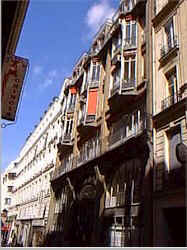 The facade’s openings correspond to the
building’s diverse usages (commerce, offices,
apartments). The three large arcades of the first two
levels stand out against the narrowness of the street.
The entry hall is filled with a large horseshoe
staircase. The rectangular windows on the third floor
contrast with the bow windows underneath. The concrete is
covered - protected or dignified? - with marine inspired
motifs such as waves, octopuses and star fish. The facade’s openings correspond to the
building’s diverse usages (commerce, offices,
apartments). The three large arcades of the first two
levels stand out against the narrowness of the street.
The entry hall is filled with a large horseshoe
staircase. The rectangular windows on the third floor
contrast with the bow windows underneath. The concrete is
covered - protected or dignified? - with marine inspired
motifs such as waves, octopuses and star fish.
The headquarters of Credit Lyonnais are being built at the end of the street,
rue du Quatre-Septembre. The original building burned
down in 1996.
2- Headquarters
of the AGF Insurance
Company, 87 rue de Richelieu
(Joseph Belmont and Pierre-Paul Heckly, Architects, 1979)
The architects wanted to create something
innovative while still respecting the scale of
Paris’ "urban fabric." Conforming to the
spirit of the haussmannien bourgeois buildings, the
"crown" evokes Paris’ typical zinc and
slate roofs. Each floor has large windows, but the
sub-basement is "hollowed out to ventilate the very
dense quartier." The large posts contain all the
technical advances (gas, electricity, telephone wires)
which ensure the floors can be planned with complete
liberty.
3- Offices and
Appartments, 24 rue Feydeau
(Fernand Colin, Architect,
1932)
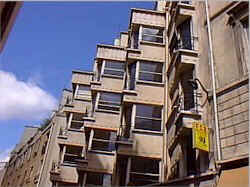 The
architect constructed an "accordion" building
due to the form of the ground underneath. This design
also served to improve the lighting in the narrow street.
The large windows overlook the nearby place de la Bourse
(Stock Exchange). The
architect constructed an "accordion" building
due to the form of the ground underneath. This design
also served to improve the lighting in the narrow street.
The large windows overlook the nearby place de la Bourse
(Stock Exchange).
Post Office, 8 place de la Bourse (Roux-Spitz et
Debat-Ponsan, Architects, 1938-1950)
4- La
Bourse, Stock Exchange, rue Vivienne, 4
place de la Bourse (www)
(metro Bourse) (tel. 01 40 41 62 20, visitors
entrance on rue des Victoires, open Monday to
Friday except holidays. Guided tours from 1:15 to 4:00
pm)
(Alexandre Brongniart, Architect, 1808)
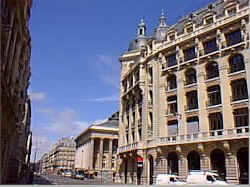 Created at the beginning of the 19th century
by Napoleon, the Stock Exchange was intended to assert
and encourage France’s prosperity in industry and
trade. In 1826 the Stock Exchange was installed in the
palace that the architect Brongniart had begun in 1808.
This palace was subsequently named after Brongniart; a
rare event in architecture. Surrounded by a large
peristyle of Corinthian columns, the rectangular
structure reflects the official neo-classicism of the
Empire Period. In 1906, the addition of two wings gave it
a cross form. The staircase is enhanced by four
allegorical statues representing Justice, Commerce,
Industry and Agriculture. Inside, the trading floor is
endowed with a stained-glass cupola. Things are still
very lively inside, despite the increasing
computerization that has diminished the excitement on the
floor. Created at the beginning of the 19th century
by Napoleon, the Stock Exchange was intended to assert
and encourage France’s prosperity in industry and
trade. In 1826 the Stock Exchange was installed in the
palace that the architect Brongniart had begun in 1808.
This palace was subsequently named after Brongniart; a
rare event in architecture. Surrounded by a large
peristyle of Corinthian columns, the rectangular
structure reflects the official neo-classicism of the
Empire Period. In 1906, the addition of two wings gave it
a cross form. The staircase is enhanced by four
allegorical statues representing Justice, Commerce,
Industry and Agriculture. Inside, the trading floor is
endowed with a stained-glass cupola. Things are still
very lively inside, despite the increasing
computerization that has diminished the excitement on the
floor.
This district became the financial
center of Paris, following the installation of a good
number of banks between the Boulevard des Italiens and
Rivoli Street. The majesty of the Exchange Building
contrasts with the liveliness of the Grands Boulevards
which are lined with cafés and shows.
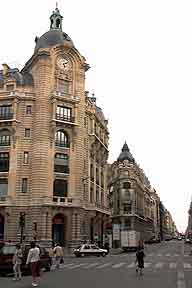 Réaumur Street contains a series of high, prestigious
buildings constructed at the beginning of the 20th
century for the great textile companies and the press.
The architects used metallic structures which were
generally hidden by a stone facade. The architects still
allowed for great bay windows however which were needed
to provide the light necessary in these activities. See
numbers 134, 126 Réaumur Street contains a series of high, prestigious
buildings constructed at the beginning of the 20th
century for the great textile companies and the press.
The architects used metallic structures which were
generally hidden by a stone facade. The architects still
allowed for great bay windows however which were needed
to provide the light necessary in these activities. See
numbers 134, 126
5- Industrial
Building, 124 rue Réaumur
(Georges Chedanne, Architect, 1905)
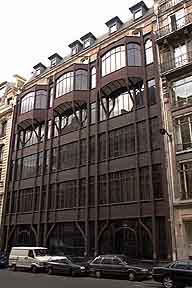 The building at #124 exemplifies the
industrial style of construction. Its facade is made of
steel beams which support the bow windows. Only metal is
used, except for the last floor where the dwellings are
made of brick. This construction does not detract from
the delicacy of the "Art nouveau" doors on the
ground floor and the curved arches in brick under the bow
windows. In addition, the layout of each floor is
different as each occupant is free to construct the
interior walls as they wish. See also numbers 118; 101;
63. The building at #124 exemplifies the
industrial style of construction. Its facade is made of
steel beams which support the bow windows. Only metal is
used, except for the last floor where the dwellings are
made of brick. This construction does not detract from
the delicacy of the "Art nouveau" doors on the
ground floor and the curved arches in brick under the bow
windows. In addition, the layout of each floor is
different as each occupant is free to construct the
interior walls as they wish. See also numbers 118; 101;
63.
6- Quartier du Sentier
A great deal of the garments for the French
fashion industry are sewn in this district. Despite the
crowded streets, the Sentier District remains the center
of ready-to-wear (pret a porter) and accessory
manufacturing. Since the 19th century, many of the
buildings are constructed with huge glass walls in order
to best capture the daylight.
7- Place du Caire. Cairo
Square, Cairo Arcade and the neighboring streets owe
their name and their Egyptian decor to the popularity of
Egypt following Bonaparte's expedition in 1798.
At #237 Saint Denis Street, the Cairo Arcade, which opened in 1798 has specialized in
lithographs and in making mannequins for store windows
ever since.
At #212 Saint Denis Street, the Ponceau Arcade has lost
its original decor.
8- Quartier Montorgueil
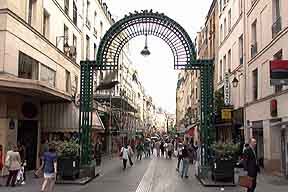 Today this is a very lively neighborhood
where the residents of surrounding districts come to
shop. Since 1990 the district has been reserved for
pedestrians, but moveable barriers allow access for
residents' cars so as to avoid a situation like that at
"Les Halles,"-one big shop window with neither
residents nor neighborhood life. The streets were paved
with bricks made of Carrare marble (but they aged badly),
benches were installed, owners were encouraged to have
the facades cleaned...and since, prostitution, which has
existed here for 8 centuries, has declined a bit.
Residents have actively debated these changes, and two
referenda were organized for individuals to express their
feelings about their surroundings. Today this is a very lively neighborhood
where the residents of surrounding districts come to
shop. Since 1990 the district has been reserved for
pedestrians, but moveable barriers allow access for
residents' cars so as to avoid a situation like that at
"Les Halles,"-one big shop window with neither
residents nor neighborhood life. The streets were paved
with bricks made of Carrare marble (but they aged badly),
benches were installed, owners were encouraged to have
the facades cleaned...and since, prostitution, which has
existed here for 8 centuries, has declined a bit.
Residents have actively debated these changes, and two
referenda were organized for individuals to express their
feelings about their surroundings.
9- Arcades rue Saint-Denis, 145 rue Saint-Denis
(débouchant rue Dussouds)
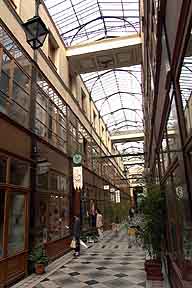 The Montorgueil District is home to several
early 19th century arcades; these shopping galleries were
illuminated by glass walls which protected pedestrians
from both bad weather and horses. The Grand Cerf arcade
has been recently restored. Its high glass walls are
classed as a historical monument, its metallic
foot-bridges, and its wooden shop-fronts were built in
1835 (145 Saint Denis Street and Dussouds Street.) The
Bourg-l'Abbé Arcade is just across the street. It begins
at 120, Saint-Denis Street and ends at Palestro Street. The Montorgueil District is home to several
early 19th century arcades; these shopping galleries were
illuminated by glass walls which protected pedestrians
from both bad weather and horses. The Grand Cerf arcade
has been recently restored. Its high glass walls are
classed as a historical monument, its metallic
foot-bridges, and its wooden shop-fronts were built in
1835 (145 Saint Denis Street and Dussouds Street.) The
Bourg-l'Abbé Arcade is just across the street. It begins
at 120, Saint-Denis Street and ends at Palestro Street.
10- Tour de Jean sans Peur, 20 rue Etienne Marcel
(tel. 01
40 26 20 28, open
13.30-18.00 on wednesday, saturdays and sundays, every
day except monday during school holidays)
 Duke
of Burgundy, Fearless John fought with Louis d'Orleans
for the throne and had him assasinated in 1407, setting
off the civil war between citizens of Armagnac and
Burgundy. Afterwards he had his mansion fortified to
protect him from counter-attacks (he was to be
assassinated in 1419.) Apart from the Clisson du Marais
mansion, this is the only vestige of feudal architecture
in Paris. The Burgundy mansion was built on the enceinte
of Philippe Auguste; a map engraved on the base of the
tower shows its original location. Falling into ruins,
the structure was demolished in 1543 by Francois Ist. Duke
of Burgundy, Fearless John fought with Louis d'Orleans
for the throne and had him assasinated in 1407, setting
off the civil war between citizens of Armagnac and
Burgundy. Afterwards he had his mansion fortified to
protect him from counter-attacks (he was to be
assassinated in 1419.) Apart from the Clisson du Marais
mansion, this is the only vestige of feudal architecture
in Paris. The Burgundy mansion was built on the enceinte
of Philippe Auguste; a map engraved on the base of the
tower shows its original location. Falling into ruins,
the structure was demolished in 1543 by Francois Ist.
To continue to Halles quarter in the First
arrondissement
To continue to Arts-et-Métiers quarter in
the Third
arrondissement
Associations of the Second
Arrondissement
Mayor and Town Hall of the Second
Arrondissement
Benoite Taffin, 8 rue de la Banque, 75 084 Paris cedex
02, Métro Bourse, tel 01 42 61 55 02
Statistical Table of
the
Second Arrondissement
Statistiques
du recensement de 1990
Sondage de l'INSEE au 1/4 |
Chiffres du 2è |
Chiffres de Paris |
Chiffres de l'agglomération
parisienne |
| Population
totale |
20 731 |
2 151 245 |
9 316 656 |
Population
par âge (en %)
0-19 ans
20-39 ans
40-59 ans
60-74 ans
+ de 75 ans |
15,9
40,6
25,3
10,3
7,9 |
18,6
35,9
24,7
12,2
8,5 |
25,5
33,8
24,7
10,2
5,7 |
Familles
(couples et enfants)
dont enfants
Personnes
habitant seules (en % des ménages)
Nombre de personnes par ménage |
12 352
3 920
56
1,76 |
1 423 932
491 292
49,8
1,92 |
7 486 068
2 920 272
33,2
2,41 |
Taux
d'activité (en %)
dont chomeurs |
64,7
11 |
60,9
9,7 |
62,5
9 |
Catégories
socio-professionnelles des
ménages
(selon personne de référence) (en %)
Agriculteurs exploitants
Artisans,
commerçants, chefs d'entreprises
Cadres professions intellectuelles sup.
Professions intermédiaires
Employés
Ouvriers
Retraités
Autres
(élèves, étudiants, "au foyer") |
0
6,3
22,1
12,9
13,7
14,4
20,3
10,4 |
0
5,5
23,4
13,9
13,8
10,5
23,4
9,4 |
0,1
5,3
18,4
16,3
14,2
17,4
22,3
6,0 |
Statut
d'occupation du logement
par
les ménages (en %)
Propriétaires-occupants
Locataires
Logés gratuitement
Logements sans
confort
= (sans salle
de bain ni WC intérieurs) |
22,9
65,6
11,6
17 |
28,3
63,0
8,7
8,1 |
40,2
54,0
5,8
3,9
|
Ménages
ne disposant pas de voitures (en %)
Actifs
travaillant à Paris
= (même
commune pour l'agglomération) |
62
78,2 |
53,7
72,9 |
34,5
33,9 |
Internet sites of the 2nd
|
 The facade’s openings correspond to the
building’s diverse usages (commerce, offices,
apartments). The three large arcades of the first two
levels stand out against the narrowness of the street.
The entry hall is filled with a large horseshoe
staircase. The rectangular windows on the third floor
contrast with the bow windows underneath. The concrete is
covered - protected or dignified? - with marine inspired
motifs such as waves, octopuses and star fish.
The facade’s openings correspond to the
building’s diverse usages (commerce, offices,
apartments). The three large arcades of the first two
levels stand out against the narrowness of the street.
The entry hall is filled with a large horseshoe
staircase. The rectangular windows on the third floor
contrast with the bow windows underneath. The concrete is
covered - protected or dignified? - with marine inspired
motifs such as waves, octopuses and star fish.  The
architect constructed an "accordion" building
due to the form of the ground underneath. This design
also served to improve the lighting in the narrow street.
The large windows overlook the nearby place de la Bourse
(Stock Exchange).
The
architect constructed an "accordion" building
due to the form of the ground underneath. This design
also served to improve the lighting in the narrow street.
The large windows overlook the nearby place de la Bourse
(Stock Exchange). Created at the beginning of the 19th century
by Napoleon, the Stock Exchange was intended to assert
and encourage France’s prosperity in industry and
trade. In 1826 the Stock Exchange was installed in the
palace that the architect Brongniart had begun in 1808.
This palace was subsequently named after Brongniart; a
rare event in architecture. Surrounded by a large
peristyle of Corinthian columns, the rectangular
structure reflects the official neo-classicism of the
Empire Period. In 1906, the addition of two wings gave it
a cross form. The staircase is enhanced by four
allegorical statues representing Justice, Commerce,
Industry and Agriculture. Inside, the trading floor is
endowed with a stained-glass cupola. Things are still
very lively inside, despite the increasing
computerization that has diminished the excitement on the
floor.
Created at the beginning of the 19th century
by Napoleon, the Stock Exchange was intended to assert
and encourage France’s prosperity in industry and
trade. In 1826 the Stock Exchange was installed in the
palace that the architect Brongniart had begun in 1808.
This palace was subsequently named after Brongniart; a
rare event in architecture. Surrounded by a large
peristyle of Corinthian columns, the rectangular
structure reflects the official neo-classicism of the
Empire Period. In 1906, the addition of two wings gave it
a cross form. The staircase is enhanced by four
allegorical statues representing Justice, Commerce,
Industry and Agriculture. Inside, the trading floor is
endowed with a stained-glass cupola. Things are still
very lively inside, despite the increasing
computerization that has diminished the excitement on the
floor. 
 The building at #124 exemplifies the
industrial style of construction. Its facade is made of
steel beams which support the bow windows. Only metal is
used, except for the last floor where the dwellings are
made of brick. This construction does not detract from
the delicacy of the "Art nouveau" doors on the
ground floor and the curved arches in brick under the bow
windows. In addition, the layout of each floor is
different as each occupant is free to construct the
interior walls as they wish. See also numbers 118; 101;
63.
The building at #124 exemplifies the
industrial style of construction. Its facade is made of
steel beams which support the bow windows. Only metal is
used, except for the last floor where the dwellings are
made of brick. This construction does not detract from
the delicacy of the "Art nouveau" doors on the
ground floor and the curved arches in brick under the bow
windows. In addition, the layout of each floor is
different as each occupant is free to construct the
interior walls as they wish. See also numbers 118; 101;
63. Today this is a very lively neighborhood
where the residents of surrounding districts come to
shop. Since 1990 the district has been reserved for
pedestrians, but moveable barriers allow access for
residents' cars so as to avoid a situation like that at
"Les Halles,"-one big shop window with neither
residents nor neighborhood life. The streets were paved
with bricks made of Carrare marble (but they aged badly),
benches were installed, owners were encouraged to have
the facades cleaned...and since, prostitution, which has
existed here for 8 centuries, has declined a bit.
Residents have actively debated these changes, and two
referenda were organized for individuals to express their
feelings about their surroundings.
Today this is a very lively neighborhood
where the residents of surrounding districts come to
shop. Since 1990 the district has been reserved for
pedestrians, but moveable barriers allow access for
residents' cars so as to avoid a situation like that at
"Les Halles,"-one big shop window with neither
residents nor neighborhood life. The streets were paved
with bricks made of Carrare marble (but they aged badly),
benches were installed, owners were encouraged to have
the facades cleaned...and since, prostitution, which has
existed here for 8 centuries, has declined a bit.
Residents have actively debated these changes, and two
referenda were organized for individuals to express their
feelings about their surroundings. The Montorgueil District is home to several
early 19th century arcades; these shopping galleries were
illuminated by glass walls which protected pedestrians
from both bad weather and horses. The Grand Cerf arcade
has been recently restored. Its high glass walls are
classed as a historical monument, its metallic
foot-bridges, and its wooden shop-fronts were built in
1835 (145 Saint Denis Street and Dussouds Street.) The
Bourg-l'Abbé Arcade is just across the street. It begins
at 120, Saint-Denis Street and ends at Palestro Street.
The Montorgueil District is home to several
early 19th century arcades; these shopping galleries were
illuminated by glass walls which protected pedestrians
from both bad weather and horses. The Grand Cerf arcade
has been recently restored. Its high glass walls are
classed as a historical monument, its metallic
foot-bridges, and its wooden shop-fronts were built in
1835 (145 Saint Denis Street and Dussouds Street.) The
Bourg-l'Abbé Arcade is just across the street. It begins
at 120, Saint-Denis Street and ends at Palestro Street. Duke
of Burgundy, Fearless John fought with Louis d'Orleans
for the throne and had him assasinated in 1407, setting
off the civil war between citizens of Armagnac and
Burgundy. Afterwards he had his mansion fortified to
protect him from counter-attacks (he was to be
assassinated in 1419.) Apart from the Clisson du Marais
mansion, this is the only vestige of feudal architecture
in Paris. The Burgundy mansion was built on the enceinte
of Philippe Auguste; a map engraved on the base of the
tower shows its original location. Falling into ruins,
the structure was demolished in 1543 by Francois Ist.
Duke
of Burgundy, Fearless John fought with Louis d'Orleans
for the throne and had him assasinated in 1407, setting
off the civil war between citizens of Armagnac and
Burgundy. Afterwards he had his mansion fortified to
protect him from counter-attacks (he was to be
assassinated in 1419.) Apart from the Clisson du Marais
mansion, this is the only vestige of feudal architecture
in Paris. The Burgundy mansion was built on the enceinte
of Philippe Auguste; a map engraved on the base of the
tower shows its original location. Falling into ruins,
the structure was demolished in 1543 by Francois Ist.